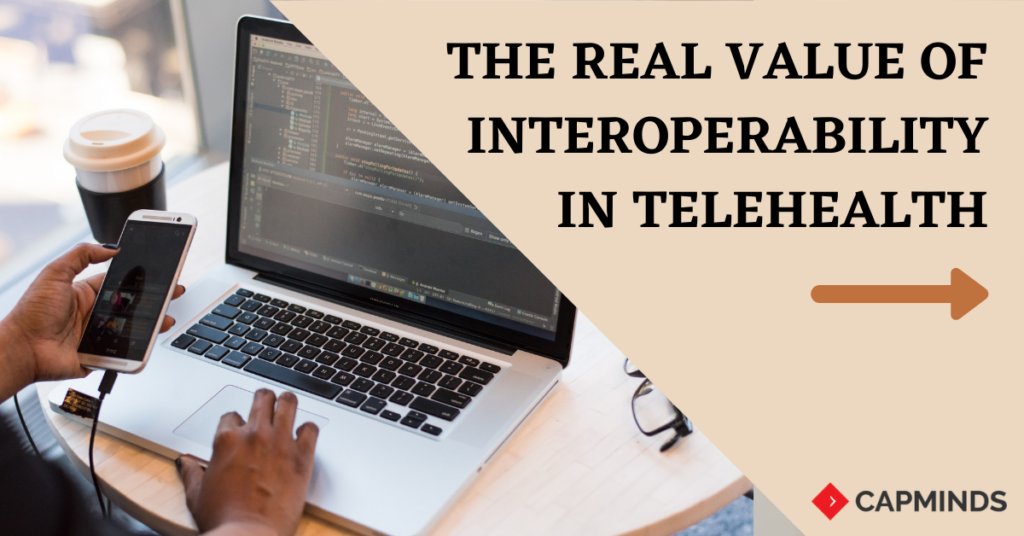The Real Value Of Interoperability In Telehealth
As healthcare organizations continue to adopt and integrate advanced technologies into care delivery, interoperability remains to be a pillar to streamline the clinical workflow. Among all, telehealth is the necessary form of healthcare delivery to address the on-demand challenges that healthcare faces in the U.S due to the outbreak of COVID-19 and to reduce healthcare costs.
As telehealth services expand day by day from the alternative method for healthcare access to integrated routine care, they will also continue to advance in productivity, quality, and financial sustainability. To achieve this, interoperability is the right key to make this happen.
Interoperability supports the secure exchange of health information across platforms to promote easy access to health data for both patients and providers. Apart from this, interoperability has positive impacts on healthcare providers, patients, payers, and as well as telehealth vendors. Why interoperability is very crucial? In this article, we explain to you the real value of interoperability in telehealth.
Interoperability And Telehealth
In the healthcare sector, interoperability has become an increasingly important topic especially when it comes to telehealth solutions. Interoperability is a giant step forward in standardized care providing secure access to the right information at the right time. To address the patients according to their needs, this timely access of health data provides efficiency in the care process improving provider workflow.
The two main areas of telehealth that are impacted by the interoperability issues are interoperability as it pertains to EHR and integrated multi-channel collaboration. Without the use of telehealth, the manual double-entry process and e-faxing will take valuable time from healthcare providers and results in data errors. With an interoperable telehealth solution, clinicians can easily automate workflows from their own EHRs. In addition to this, the patient health record can be automatically updated with the consultation results captured in the integrated telehealth platform.
RELATED: HEADING TOWARDS THE FUTURE OF HEALTHCARE INTEROPERABILITY
Patient Safety Considerations for Interoperable Solutions
The implementation of telehealth will enhance healthcare accessibility and quality of care. Anyway, it is important to safeguard the patient data throughout the process. The key factors are:
Care Model Selection
Patient and Practitioner Preferences: Consider the characteristics and needs of your patient population, as well as the preferences of your practitioners.
Hybrid Model: A hybrid model, while integrating in-person and telehealth visits leads to effective follow-up care and particular specialties.
Patient Satisfaction: Prioritize patient satisfaction to ensure a positive telehealth experience.
Document and Image Management:
Scope Interoperability: An interoperable solution is a feature to share large volumes of documents and images, improving patient involvement and understanding.
Image Capture and Storage: According to the type of patient visit, video capture or photography may be a supportive one.
Telehealth Peripherals
Frequant Assessments: Make sure that the Patient’s health condition is suitable for a telehealth visit and use peripherals like remote stethoscopes, and otoscopes to improve assessments.
Remote Patient Monitoring: For a patient with chronic diseases or any other health issues, RPM can enable remote patient monitoring, and the rate of hospitalization has been reduced. for more than two participant locations to adopt interpreters, specialists, or guardians.
The Role Of Standards In Interoperability
The technology standards play an important role in enabling interoperability in telehealth across all established systems. Newer interoperability specifications such as SMART on FHIR build on existing standards for patient data exchange and imaging such as HL7 allow organizations to more easily integrate services.
The Growing Demand For Telehealth Impacted Interoperability
As the COVID-19 pandemic continues to spread worldwide, the need for telehealth becomes greater than before. Everyone started using virtual care visits for secure and timely consultations with their physicians. This expands the need from EHR interoperability to telehealth interoperability and how both the patients and providers see, hear and capture relevant health data.
When compared to the previous digital technologies like EMR platforms, healthcare organizations experienced better outcomes with telehealth. It’s not only about the video visits, it’s the technological innovation that improves the quality of health care offered to patients. CMS also presented advanced payment models to support the broad use of the telehealth platform wherever possible.
RELATED: ROLE OF INTEROPERABILITY IN CARE COORDINATION
Telehealth Interoperability Into The Future
Interoperability in telehealth is important now, but achieving successful results on its complex challenges is an investment over time. As telehealth solutions become a must-have platform, finding the best platform specifically designed to help the unique needs of patients and providers is very much essential.
CapMinds cloud-based telehealth platform and interoperability solutions deliver 100% live access to patients from any remote location and ensure secure physician mobility. To learn more about our interoperability services contact us today!




